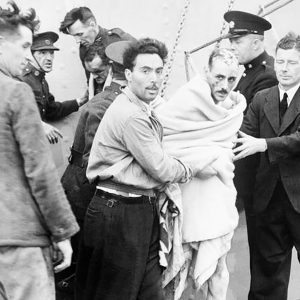On 3rd September 1939, the transatlantic passenger liner S.S. Athenia sank in the North Atlantic. Built in Glasgow in 1923, the vessel served the Donaldson Atlantic Line between the United Kingdom and Canada. Hours after Britain declared war on Germany, U-30 torpedoed the liner in the Western Approaches.
The sinking of S.S. Athenia saw the loss of 117 passengers and crew. Condemned as a war crime, this was the Donaldson Line’s greatest loss of life at sea.
Departure for Montreal
On 1st September 1939, Captain James Cook sailed S.S. Athenia from Glasgow, Scotland. The vessel was bound for Montreal, Quebec, Canada via Liverpool, England and Belfast. On board were 1,103 passengers including around 500 Jewish refugees. There were 469 Canadians, 311 Americans, 72 British citizens, and 315 crew members.
Despite an awareness that the outbreak of the Second World War was imminent, Athenia departed Liverpool on 2nd September 1939. By the following day, the vessel was 110km south of Rockall and 370km north-west of Inistrahull, an island off the coast of Donegal, Éire. At 1630hrs, Oberleutnant Fritz-Julius Lemp spotted Athenia. He later claimed the darkened ship on a zigzag route lead him to believe it to be a troopship or an armed merchant cruiser.
After tracking the British liner for 3 hours, Lemp fired 2 torpedoes from U-30 at 1940hrs. Both vessels were between Rockall and Tory Island. One torpedo struck the engine room on the port side and Athenia put forth a distress signal.
Rescue Efforts
F-Class destroyer H.M.S. Fame carried out an anti-submarine sweep of the area. E-Class destroyers H.M.S. Electra and H.M.S. Escort joined Swedish Yacht Southern Cross, Norwegian Tanker M.S. Knute Nelson, and American Cargo Ship City of Flint in rescuing survivors. S.S. Athenia sank stern first at 1040hrs on 4th September 1939 after remaining afloat for 14 hours. A total of 98 passengers and 19 crew members died as a result of the attack.
Around 50 those who died did so when the propeller of M.S. Knute Nelson crushed a lifeboat. Another lifeboat capsized below the stern of Southern Cross causing the death of 10 more. A further 3 passengers died in a crush to transfer from a lifeboat to one of the Royal Navy ships.
At the time, Germany denied the sinking by one of their vessels. They feared the death of 28 American citizens may prompt the United States of America to join the Allied war effort. German newspaper Volkischer Beobachter claimed the United Kingdom was responsible for the sinking in an attempt to blame the Nazis. An admission of responsibility only came during the Nuremberg Trials in 1946.





